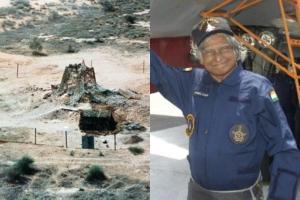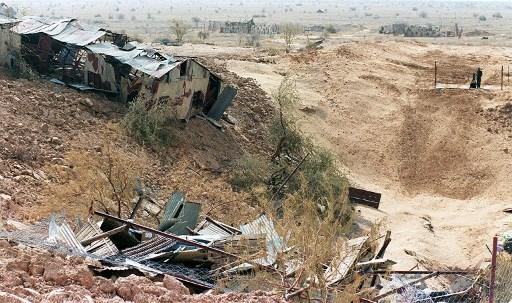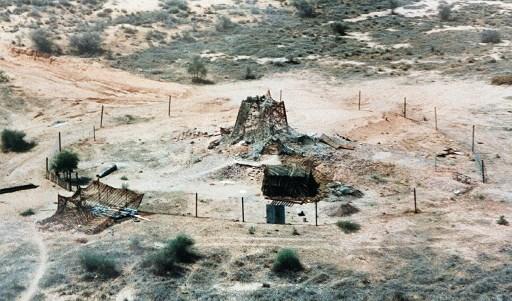Abdul Kalam was codenamed Major General Prithvi Raj and Rajagopala Chidambarams alias was Natraj

Pics:AFP
Dr. Avul Pakir Jainulabdeen Abdul Kalam was born on October 15, 1931, in Rameswaram in Tamil Nadu. A brilliant child, he went on to add a golden page to the glorious history of India and became its 11th President.
He specialised in Aeronautical Engineering from Madras Institute of Technology and later joined the Defence Research and Development Organisation (DRDO). He was also the scientific adviser to Defence Minister and Secretary, department of Defence Research & Development from July 1992 to December 1999.

Pic/AFP
During this time, under the leadership of then Prime Minister Atal Bihari Vajpayee, he executed multiple nuclear tests in the Pokhran test range of Rajasthan.
1. Atal Bihari Vajpayee wanted to execute this mission in 1996 right after he took office but due to political disturbances, the mission was stalled for two years.
The tests in Pokhran in 1998 also showed the difference a strong political leadership can make. Proud Day for Every Indian, Jai Hind ... ðÂÂu00c2u009fÂÂu00c2u0087®ðÂÂu00c2u009fÂÂu00c2u0087³ðÂÂu00c2u009fÂÂu00c2u0087®ðÂÂu00c2u009fÂÂu00c2u0087³âÂÂu00c2u009d¤ï¸ÂÂu00c2u008fâÂÂu00c2u009d¤ï¸ÂÂu00c2u008fðÂÂu00c2u009fÂÂu00c2u0099ÂÂu00c2u008f#Pokhran2#पà¥ÂÂu00c2u008bà¤ÂÂu00c2u0096रण pic.twitter.com/Bo7bxJ71ST
— पिपिहरà¥ÂÂu00c2u0080 वादà¤ÂÂu00c2u0095 - à¤ÂÂu00c2u0095ालà¥ÂÂu00c2u0080 पहाà¥ÂÂu00c2u009cà¥ÂÂu00c2u0080 मà¥ÂÂu00c2u008dयà¥ÂÂu00c2u0082à¤ÂÂu00c2u009cिà¤ÂÂu00c2u0095 à¤ÂÂu00c2u0086रà¥ÂÂu00c2u008dà¤ÂÂu00c2u0095à¥ÂÂu00c2u0087सà¥ÂÂu00c2u008dà¤ÂÂu00c2u009fà¥ÂÂu00c2u008dरा#BMJ (@upadhyay51) May 11, 2020
On May 11, 1998, Kalam and the team successfully carried out the test firing and hoodwinked the western surveillance over Pokhran, issued to monitor India’s nuclear activities after the 1974 successful Pokhran-I codenamed ‘Operation Smiling Buddha’.

The Shakti-3 nuclear site after a nuclear device was detonated underground 11 May, 1998 | Pic: AFP
2. Pokhran-II was a series of five nuclear bomb test explosions. It consisted of five detonations, of which the first was a fusion bomb and the remaining four were fission bombs.
3. After the operation was carried out successfully for which Kalam had been camping in the Thar Desert for over a fortnight, the then Scientific Advisor to Vajpayee, sent a message on the hotline, saying, "Buddha smiles again".

Pic:AFP
4. Not many know how intensely this operation was kept a secret. Owing to surveillance, the scientists worked strategically to keep this mission away from the eyes of outsiders and even some insiders including George Fernandes. The then defence minister was not made aware of a confidential meeting that took place between Vajpayee, Kalam and Rajagopala Chidambaram (then atomic energy chief) to discuss the nuclear weapon tests.
India conducted five underground nuclear tests at Pokhran test range in May 11-13 ,1998.
— रà¤ÂÂu00c2u0095à¥ÂÂu00c2u008dषा मà¤ÂÂu00c2u0082तà¥ÂÂu00c2u008dरà¥ÂÂu00c2u0080 à¤ÂÂu00c2u0095ारà¥ÂÂu00c2u008dयालय/ RMO India (@DefenceMinIndia) May 12, 2018
On the 20th anniversary of #Pokhran2, sharing some photographs of the event.
In picture: Former PM Shri Atal Bihari Vajpayee with Department of Atomic Energy Scientists at Pokhran#Pokhran2 pic.twitter.com/hSQPylJP5t
5. The scientists worked only at night so that satellites would be unable to capture clear images of the region. They would place everything just as the previous day before dawn. Abdul Kalam was codenamed Major General Prithvi Raj and Rajagopala Chidambaram’s alias was “Natraj”.
20 Years Ago, This Day India Did 3 Successful Nuclear Tests And Became A Nuclear State. This Operation Was So Secret Even CIA Was Not Aware Of It. Scientists Disguised In Army Dresses To Go To The Sites. They Created Their Own Language To Converse.
— Sir Jadeja fan (@SirJadeja) May 11, 2018
Salute To Them.ðÂÂu00c2u009fÂÂu00c2u0099ÂÂu00c2u008fðÂÂu00c2u009fÂÂu00c2u0091ÂÂu00c2u008f #Pokhran2 pic.twitter.com/LfucKCuasp
6. On May 11, 1998, India test-fired its ‘Shakti-1’ nuclear missile in operation called ‘Pokhran-II’, also codenamed as Operation Shakti. Two days after, two more such tests were carried on as part of the same operation. The success of this mission made India a part of the elite club of nuclear nations.
Keep scrolling to read more news
Catch up on all the latest Crime, National, International and Hatke news here. Also download the new mid-day Android and iOS apps to get latest updates.
Mid-Day is now on Telegram. Click here to join our channel (@middayinfomedialtd) and stay updated with the latest news
 Subscribe today by clicking the link and stay updated with the latest news!" Click here!
Subscribe today by clicking the link and stay updated with the latest news!" Click here!









